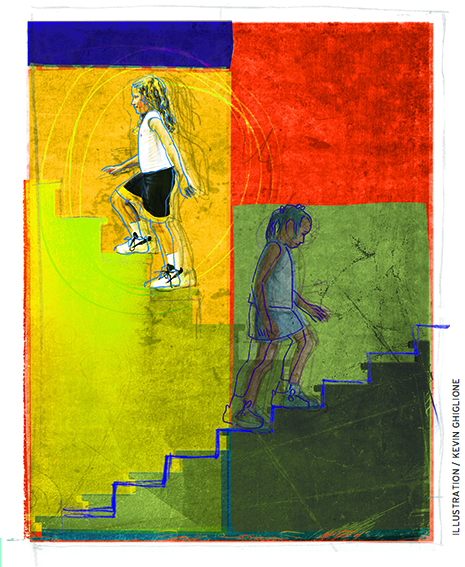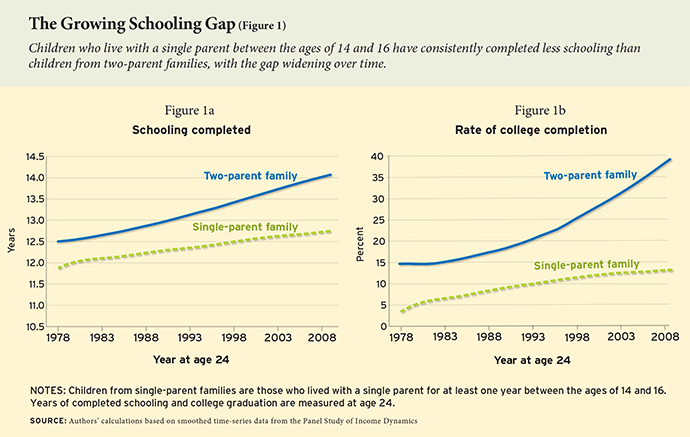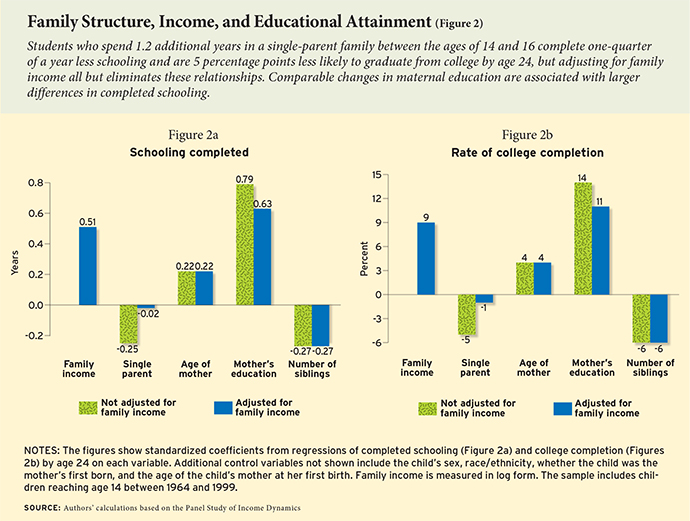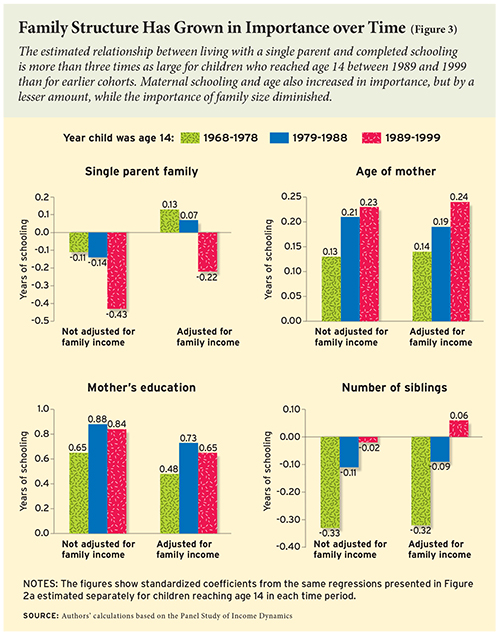This article is part of a new Education Next series on the state of the American family. The full series will appear in our Spring 2015 issue to mark the 50th anniversary of the 1965 release of Daniel Patrick Moynihan’s report “The Negro Family: The Case for National Action” (generally referred to as the Moynihan Report).
 One of the most alarming social trends in the past 40 years is the increasing educational disadvantage of children raised in low-income families. Differences between low- and high-income children in reading and math achievement are much larger now than they were several decades ago, as are differences in college graduation rates.
One of the most alarming social trends in the past 40 years is the increasing educational disadvantage of children raised in low-income families. Differences between low- and high-income children in reading and math achievement are much larger now than they were several decades ago, as are differences in college graduation rates.
What might account for these increasing achievement and attainment gaps? One obvious suspect is income inequality itself, which has increased dramatically during the same period. But income inequality is hardly the only factor that may be widening the gaps. We focus here on the central concern of the Moynihan Report: the rise of single-parent families, which has been much more rapid among those with low incomes than among those with high incomes, and indeed has fueled some of the increasing income inequality.
The Moynihan Report focused on black families, but the rise in single-parent families transcends racial and ethnic boundaries. Data from the Current Population Survey show that between 1960 and 2013, the proportion of black children living with a single parent more than doubled (from 22 percent to 55 percent); for white children, the percentage more than tripled (from 7 percent to 22 percent).
Turning from race to class differences, we find that more than half (51 percent) of low-income children entering adolescence were living in single-parent families around the time the Moynihan Report was published. This figure jumped to 75 percent over the next three decades. The corresponding increase for adolescents in high-income families over that period is much smaller, from 3 percent to 6 percent. If the single-parent family structure adversely affects children’s educational outcomes, then the difference in trends across income groups could possibly account for more of the growing gap in educational attainment between rich and poor children than income inequality itself.
In the analysis presented below, we examine the relationships between children’s completed schooling and a number of factors, including single-parent family structure. We find that, while statistically significant, the strength of the relationship between living with a single-parent family and educational attainment is comparable to the relationships for family size and the age of the mother at the time of the child’s birth and weaker than the relationship for maternal schooling. Troublingly, however, the negative relationship between living with a single parent and educational attainment has increased markedly since the time the Moynihan Report was published. In other words, American children raised in single-parent homes appear to be at a greater disadvantage educationally than ever before.
The Data
Our analysis is based on data from the Panel Study of Income Dynamics (PSID), spanning 31 cohorts of children born between 1954 and 1985. The PSID has followed a nationally representative sample of families and their children since 1968. Our sample consists of 6,072 individuals from whom information was collected on parental income and other characteristics between the ages of 14 and 16 and on completed schooling at age 24. Our key measure is the amount of time between the ages of 14 and 16 that the child lived with a single parent. Throughout our analyses, we adjust for three other family characteristics that may separately influence a child’s educational attainment: mother’s age at the child’s birth, level of schooling the mother had completed when the child was 14 years old, and number of siblings born to the child’s mother. In some analyses, we also adjust for the average parental income when the child was between the ages of 14 and 16. Additional control variables include the child’s sex and race/ethnicity, whether the child was the mother’s firstborn, and the age of the child’s mother at her first birth.
On average over the 31-year period, children the PSID followed into early adulthood completed 13.2 years of schooling by age 24, and 22.4 percent had completed college. They spent 22 percent of the years between ages 14 and 16 living with a single parent, with 26 percent spending any of those years living with a single parent. And their mothers were about 26 when these children were born and had completed 12.2 years of education by the time their children were 14 years old.
The educational attainment gap for adults who lived in single-parent families in adolescence widened considerably over this period. Figure 1a shows the evolution of the gap in years of completed schooling by age 24 between children who, between the ages of 14 and 16, never lived with a single parent and those who lived with a single parent at least one of the three years. While both groups saw increases in years of completed schooling over time, the gap between them widened from 0.63 years for those who were age 24 in 1978 to 1.32 years for those who were age 24 in 2009. This widening appears to accelerate around the mid- to late 1990s. Figure 1b shows similar trends in college completion rates, with the gap between the groups roughly doubling over the 31 years, from 12 to 26 percentage points.

The Role of Single-Parent Families
While the gap in educational attainment by family structure has widened over time, factors beyond family structure may be responsible for that trend. Figure 2 shows the results of our efforts to explain the amount of schooling children completed through five factors: family structure, mother’s age at child’s birth, mother’s years of education, the number of siblings, and parental income. When modeling the relationship between these variables and educational attainment, we control for mother’s age at first birth and whether the individual was the firstborn, along with gender and race or ethnicity. Finally, we report the results of models with and without adjusting for differences in parental income to show to what extent the estimated relationships between each of the factors and educational attainment might reflect associated differences in income. For example, we would think differently about the nature of disadvantages imparted by single-parent family structure if all of the association between living in a single-parent family and completed schooling could be accounted for by lower family income.
To facilitate comparisons across the five key explanatory variables, which are measured in different units, the figures report the change in completed schooling associated with an increase of one standard deviation in each one. For the single-parent family measure, this represents an increase of 40 percentage points (1.2 years) in the amount of time between the ages of 14 and 16 the child spent living with a single parent. The comparable changes for the other variables are 5.7 years for the mother’s age at child’s birth, 2.6 years for mother’s years of education, 2.1 for number of siblings, and a 69 percent increase in parental income.
Figure 2a shows that, holding constant all demographic measures other than income, an increase of one standard deviation in the single-parent measure is associated with a drop in children’s completed schooling of one-quarter of a year. Similar results are obtained for changes in maternal age at birth and number of siblings. In contrast, an equivalent change in the amount of maternal schooling adds about three-quarters of a year to children’s completed schooling. Including the income variable in the model all but eliminates the estimated relationship between single-parent family structure and educational attainment, suggesting that differences in parental income play a key role in the educational disadvantage facing students raised in single-parent families. Adjusting for differences in parental income makes little difference for the other key variables.
Findings are similar with respect to college graduation (see Figure 2b). Here again, maternal schooling is the dominant predictor of differences in educational attainment. An increase of one standard deviation in the level of maternal schooling increases the likelihood of graduating from college by 14 percentage points, nearly three times as much as the corresponding effect for single-parent family structure (5 percentage points). Once again, including the income variable in the model greatly reduces the estimated relationship between single-parent family structure and educational attainment.

While these findings may seem to call into question the importance of family structure on its own for predicting children’s educational attainment, two qualifications are in order. First, recall that Figure 2 shows the change in completed schooling associated with a change of one standard deviation in each of the relevant predictors. For the single-parent family variable, this amounts to an increase of 1.2 years in the amount of time children spent living with one parent between the ages of 14 and 16. The vast majority of children in our sample, however, spent either none of those years or all three of those years in a single-parent family. Spending all three years in a single-parent family, as opposed to none, was associated with completing 0.63 fewer years of schooling and a reduction of 13 percentage points in the probability of graduating from college in models that do not control for family income.
 Second, the predictive power of single-parent family structure appears to have increased over time. The results for living with a single parent illustrated in Figure 2 combine data for all 31 cohorts. If we divide the period into three spans of about 10 years (1968–78, 1979–88, and 1989–99), we find that the estimated relationship between the single-parent family structure variable and educational attainment more than tripled in size, from -0.11 for the earliest cohorts to -0.43 in the latest cohorts (see Figure 3). By the final time span, living with a single parent all three years between ages 14 and 16, rather than none, was associated with completing 0.92 fewer years of schooling compared to 0.31 fewer years in the first period.
Second, the predictive power of single-parent family structure appears to have increased over time. The results for living with a single parent illustrated in Figure 2 combine data for all 31 cohorts. If we divide the period into three spans of about 10 years (1968–78, 1979–88, and 1989–99), we find that the estimated relationship between the single-parent family structure variable and educational attainment more than tripled in size, from -0.11 for the earliest cohorts to -0.43 in the latest cohorts (see Figure 3). By the final time span, living with a single parent all three years between ages 14 and 16, rather than none, was associated with completing 0.92 fewer years of schooling compared to 0.31 fewer years in the first period.
The estimated relationship between the single-parent family structure variable and the probability of graduating from college doubled. By the final time span, living with a single parent all three years between ages 14 and 16, rather than none, was associated with reduced probability of graduating from college of 16.6 percentage points compared to a reduction of 8.1 percentage points in the first period.
The relationships with educational attainment for the three other key factors—maternal age at the child’s birth, maternal education, and number of siblings—were also changing over the 31-year period, although generally by less than that for single-parent family structure. The associations between maternal age at birth and children’s completed schooling nearly doubled in size, from 0.13 for the earliest cohorts to 0.23 in the latest cohorts. The association for maternal education also increased modestly, while the association for number of siblings fell to zero for the latest two cohorts.
Conclusion
Single-parent families are much more prevalent now than at the time the Moynihan Report was published. They are still far more likely to be found among low-income families than among high-income families, but they have become more common among both whites and blacks.
Our analysis focused on the relationships between completed schooling and a number of characteristics, including living with a single parent as adolescents. We find that the estimated relationships between living with a single parent and educational attainment are similar to those for family size and the age of the mother at the time of the child’s birth but considerably smaller than the effects of the mother’s level of education. Importantly, however, the negative relationship between the single-parent family and children’s completed schooling appears to be larger now than when the Moynihan Report was published. We need to continue to monitor these patterns and examine what it is about family resources and processes in single-parent families that may result in low levels of educational attainment for children.
Kathleen M. Ziol-Guest is research associate professor at New York University’s Steinhardt School of Culture, Education, and Human Development. Greg J. Duncan is professor of education at the University of California, Irvine. Ariel Kalil is professor at the Harris School of Public Policy Studies at the University of Chicago.
This article appeared in the Spring 2015 issue of Education Next. Suggested citation format:
Ziol-Guest, K.M., Duncan, G.J., and Kalil, A. (2015). One-Parent Students Leave School Earlier: Educational attainment gap widens. Education Next, 15(2), 36-41.


